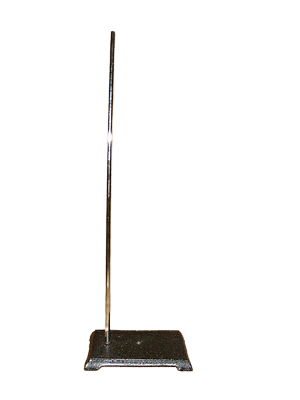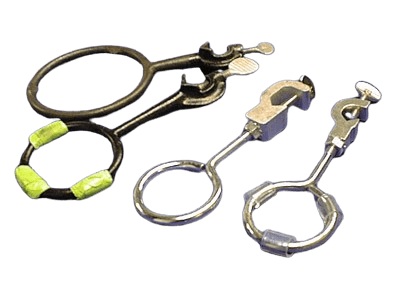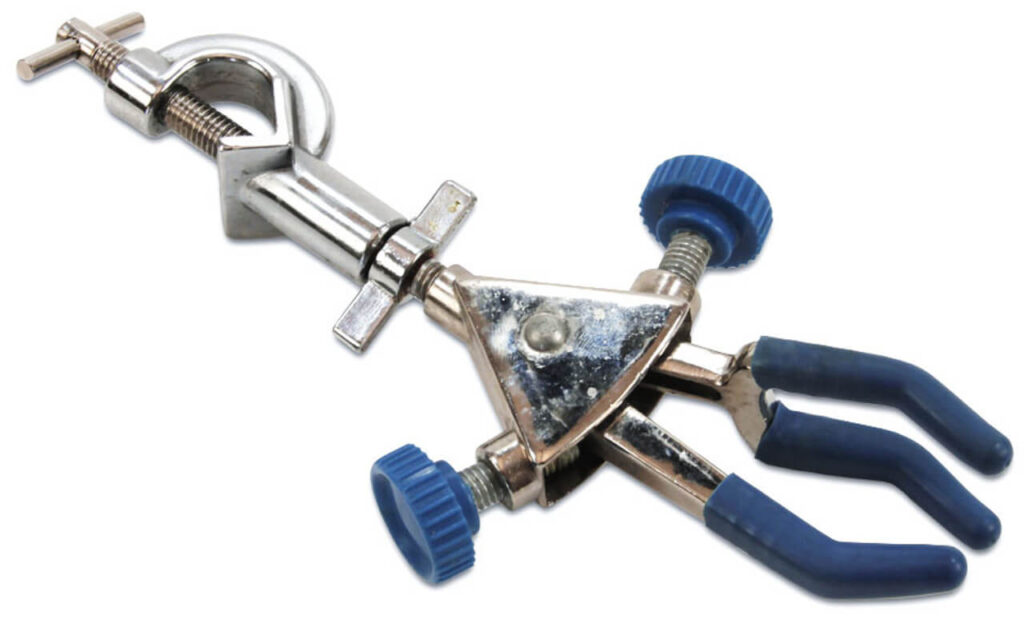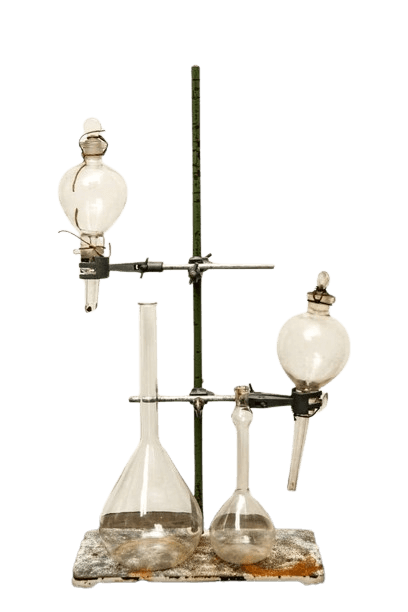In chemistry laboratories, ring stands are used to hold and support pieces of apparatus (burettes, beakers, conical flasks, test tubes, funnels, etc.) during experiments. They are also called clamp stands, support stands, or retort stands.

As you can see in the diagram 1 above, a ring stand has a heavy base (to make it more stable) and an upright rod to support pieces of apparatus.
The upright rod extends up to 750mm in height, which is sufficient for the majority of chemistry experiments. This height is also compatible with most fume hoods, so you don’t have to worry about clearance when conducting experiments in enclosed spaces like in fume hoods.
However, certain experiments may necessitate a taller rod, particularly when handling large tubes or bulky chemical bottles. In such instances, you can enhance stability by substituting the solid base with a tripod.
Ring clamps, Versatile clamps, or 3-prong clamps are usually attached to the stand, allowing various laboratory apparatus to be securely held in place. This helps to ensure the safety and efficiency of the overall experimental setup.
If you’re wondering when to use a ring, versatile, or three-prong clamp, here’s a quick explanation to guide you through their uses.
Ring Clamps

Ring clamps typically consist of a sturdy metal frame with circular ends designed to hold laboratory glassware or apparatus securely.
Cut rubber or Tygon tubing may be added to the circular end to serve as a cushion to the glassware and to ensure a secure grip.
The ring clamp is attached to the vertical rod of a ring stand via an adjustable screw mechanism. This mechanism allows the clamp to be easily adjusted and tightened onto the ring stand for stability. By loosening or tightening the screw, the user can adjust the height and position of the clamp as needed to accommodate different sizes of glassware or apparatus.
CAUTION: When subjected to heat, rubber or Tygon tubings are susceptible to catching fire. Therefore, it is advisable to choose ring clamps without such materials when conducting experiments involving heating.
Versatile Clamps

As you can see in the diagram, versatile clamps connect to a ring stand on one end and to glassware or apparatus on the other end. Like Ring clamps, the end that attaches to the ring stand has an adjustable screw mechanism to allow the clamp to be easily adjusted and tightened onto the stand.
They feature a nut in the middle that can be loosened, allowing the clamp to pivot and adjust its direction. This flexibility is why they are called “Versatile” clamps.
Over time, the wing nut on the clamp may wear out, leading to the clamp no longer staying securely closed. If you encounter this issue, consider trying a different wing nut to ensure the proper functionality of the clamp.
3-Pronged Clamps

3-pronged clamps are more flexible or versatile than even the Versatile Clamps because they can hold different shapes and sizes of glassware or apparatus and turn in any direction you need. The prongs usually have rubber or plastic coatings to serve as a cushion to the glassware and keep it firmly in place.
Like Ring and Versatile clamps, a 3-pronged clamp needs to be attached to the vertical rod of a Ring Stand for stability. To do so, a clamp holder is necessary because the clamp can’t hook directly onto the ring stand. Once you attach the clamp holder, you can leave it on the clamp for next time to make your subsequent setup quicker and easier.
Uses of a Ring Stand

Now that you’ve got a grasp of the basics of the ring stand, you might be curious about the types of experiments that require these stands in the laboratory. Ring stands play a crucial role in supporting apparatus during various experiments. Consider any experiment where you need to keep apparatus over flames, hot plates, or water baths for extended periods, or where you need to suspend apparatus securely without the risk of reagents falling or shifting. In such experiments, a ring stand is indispensable.
Such experiments include but not limited to:
- Condensation Experiments: In experiments that involve distillation or reflux, Ring stands is needed to provide a stable support for condensers, allowing them to be positioned at the appropriate height above the reaction vessel for efficient cooling and condensation of vapors.
- Titration Experiments: During titration experiments, burettes need to be securely held in place to ensure accurate measurements of reagents. This allows for precise control over the addition of titrant to the reaction mixture.
- Filtration Experiments: During filtration procedures, ring stands can support filtration funnels in conjunction with Büchner funnels, Hirsch funnels, or filter flasks.
- Distillation Experiments: Ring stands can also be used to support distillation flasks while allowing space for the insertion of heating elements beneath the flasks.
- Catalysis Experiments: Ring stands can serve as a platform for supporting catalysts or catalytic reactors in chemical reactions where catalysis is required. By attaching the catalyst container or reactor vessel to the stand, you can conduct reactions under controlled conditions while ensuring efficient contact between reactants and catalysts.
Safety Guidelines for Using a Ring Stand In the Lab
When using a ring stand in the lab, it is crucial to follow a few safety guidelines to prevent accidents:
- Secure Attachment: Always ensure that the apparatus attached to the Ring stand is securely fastened to prevent it from falling off during experiments.
- Stable Positioning: Position the ring stand on a stable surface to prevent it from tipping over, ensuring a safe working environment
- Adjustment and Tightening: Adjust the position of clamps or rings on the vertical rod as needed and tighten them securely to keep the equipment in place during experiments
- Heat Safety: When using the ring stand in experiments that involve heating, be cautious of the heat generated by burners and glassware. Allow the equipment or apparatus to cool for at least 10 minutes before handling or dismantling the stand setup after heating.
Apart from these safety tips, strive to adhere to all other laboratory safety rules. Check this post for a quick overview of the basic lab safety rules for students.
As you can see, ring stands are really important in the lab. They help keep things steady and safe during experiments. Whether you’re heating something up or just need to keep apparatus in place, ring stands come in handy in helping you set up things properly.



